
On March 28 and 29, 2020, the waxing crescent moon and dazzling planet Venus will pop out almost immediately after sunset, lighting up the western evening twilight. Given clear skies, they’ll be hard to miss! You can use the moon and Venus on these evenings to locate the constellation Taurus the Bull, with its brightest star Aldebaran and the famous Pleiades star cluster, also known as the Seven Sisters.
Unlike the stars, which shine by their own light, the moon and Venus shine by reflecting the light of the sun. They are literally heavenly bodies basking in sunshine.
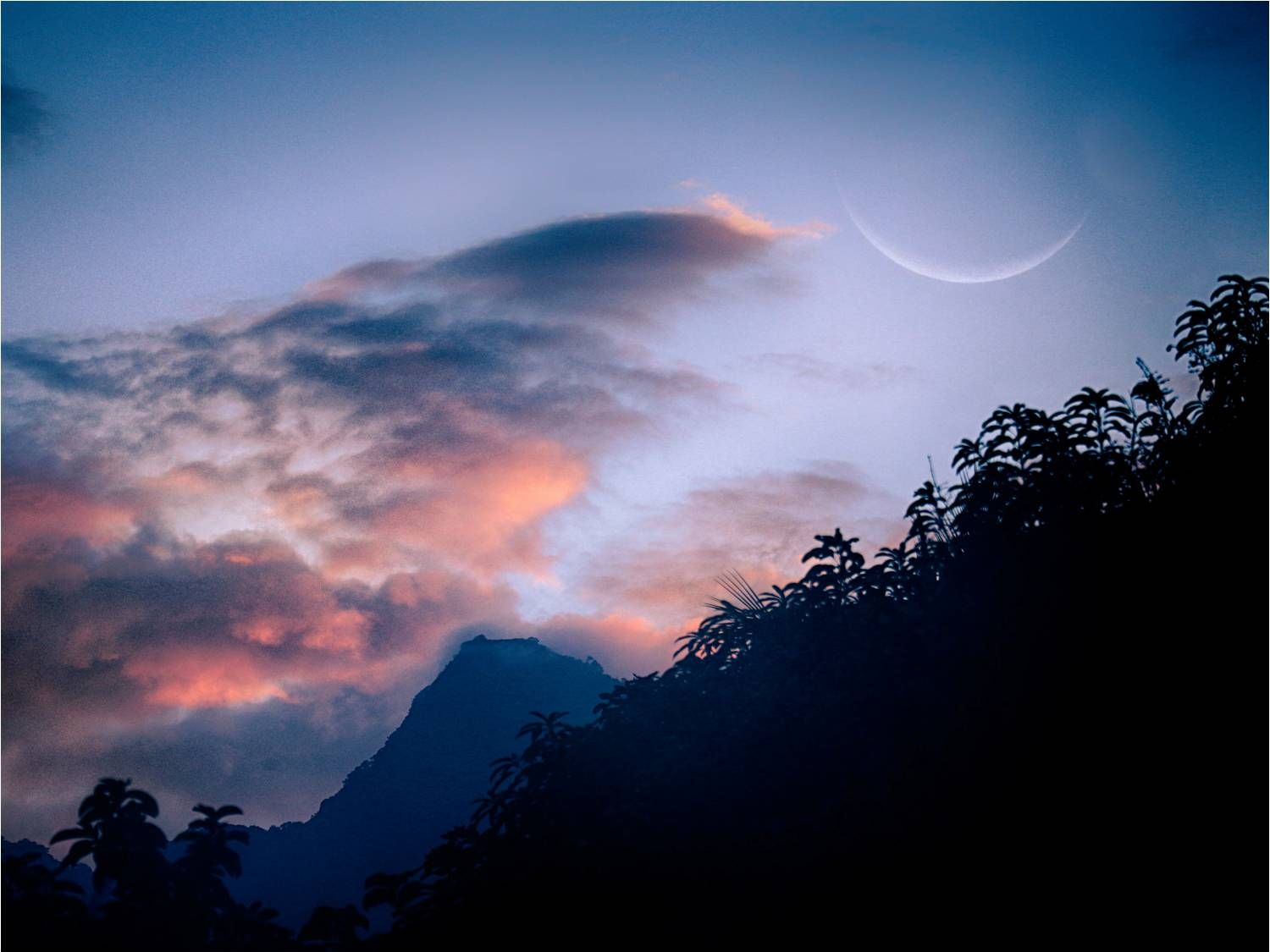
View at EarthSky Community Photos. | Dr Ski in Valencia, Philippines, created this beautiful composite photo of the moon from images captured on March 27, 2020. He wrote: “A wise man once told me that Nature’s beauty, indeed life itself, was made to be embellished. In that light, I decided to capture 2 nice images taken at different focal lengths and present them as one. I’m trying to convey my feeling of wonder and awe as I was enjoying the western view from the Observatory. Being confined in an Observatory is not so bad.” Thank you, Dr Ski!
The Pleiades cluster looks like a tiny dipper. It’s more dipper-like, some think, than the famous Big Dipper asterism, now in the northeast in the evening. Although the Pleiades are also called the Seven Sisters, most people see six stars here. Binoculars show more stars in the Pleiades, and a telescope reveals that this tiny pattern within Taurus is an actual open cluster of several hundred stars.
The star Aldebaran depicts Taurus the Bull’s ruddy eye, and highlights a V-shaped assemblage of stars that outlines the Bull’s face. These stars (with the exception of Aldebaran) make up another open star cluster, called the Hyades. Like the stars in the Pleiades, the Hyades stars are siblings, born from a single cloud of gas and dust. Aldebaran, at a distance of 65 light-years, just happens to be on the same line of sight as this cluster. The Hyades cluster resides well over twice Aldebaran’s distance, at a distance of 150 light-years.
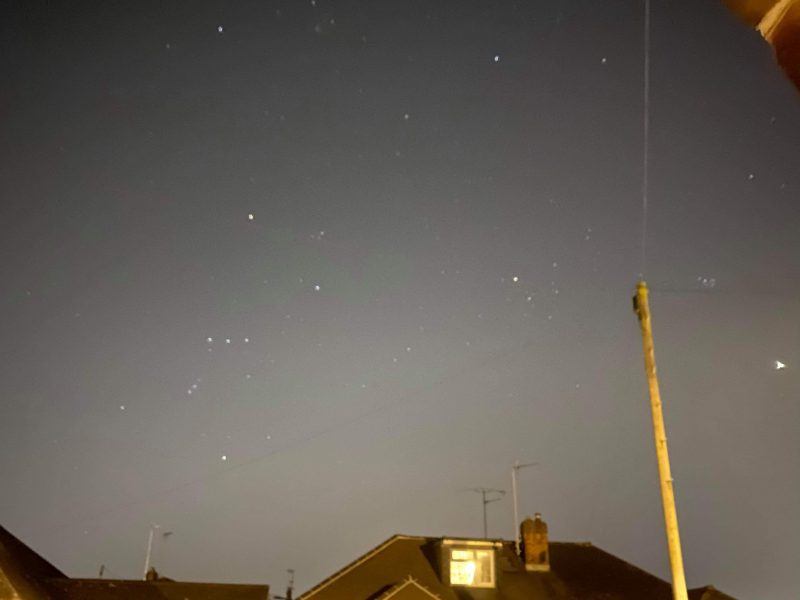
View at EarthSky Community Photos. | Vic Pablo in Luton, Bedfordshire, U.K., caught Venus (brightest object in image, to the right of the pole), and the constellations Orion and Taurus, on March 26, 2020. He wrote: “Facing west an image of Orion constellation on top of the roof. Also visible is Venus and Pleiades on the right side of the wooden post. Aldebaran, Capella and Pollux which is part of Winter Circle is on the background.” Thank you, Vic!
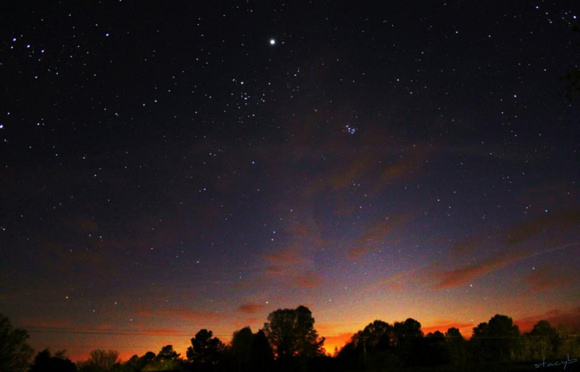
Photo of the planet Jupiter and the constellation Taurus by Stacy Oliver Bryant on April 6, 2013. Note the three stars of Orion’s Belt at upper left. Orion’s Belt always points to the star Aldebaran and the Pleiades star cluster
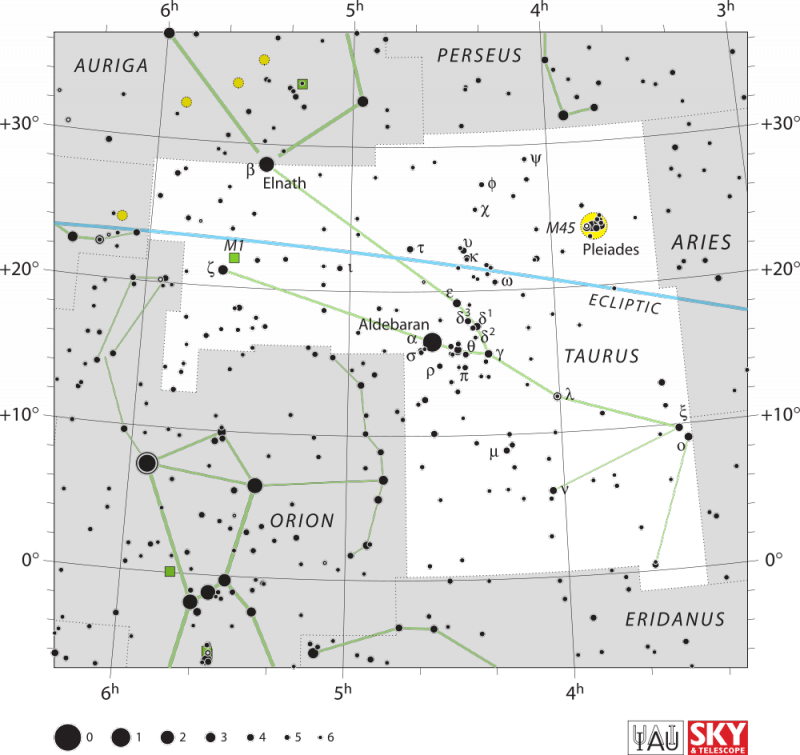
The 3 stars at the midsection of Orion – called the Belt of Orion – always point to the bright red star Aldebaran, in the V-shaped face of Taurus the Bull. Chart via IAU.
The lit side of the waxing crescent points westward, or in the direction of sunset. Although the moon appears to travel westward (in the sunset direction) every day, this is not the moon’s true motion. The moon, planets and stars appear to travel westward across the sky for the same reason that the sun appears to travel westward during the day. The Earth spins from west-to-east on its rotational axis every day, making it appear as if the sun, moon, planets and stars actually move from east to west daily. But it’s really the rotating Earth that is doing the moving.
However, the dark side of the waxing moon points in the moon’s direction of travel relative to the stars and planets of the zodiac. The moon moves in front of the background stars at the rate of about 1/2 degree per hour or about 13 degrees eastward per day. At the same time for these next several evenings, note the moon’s change of position relative to the “fixed” star, Aldebaran. This is the true measure of the moon’s orbital motion around Earth. Watch for the moon to traverse eastward through the constellation Taurus the Bull these next several days.
By the way, Venus reached its greatest elongation from the setting sun on March 24. Although Venus is now moving westward relative to the sunset, Venus is moving eastward relative to the backdrop stars of the zodiac, but at a slower pace than the moon. Watch the Venus to pass a scant 0.3 degrees south of the Pleiades star cluster on April 3, 2020, and a whopping 10 degrees north of Aldebaran in mid-April 2020. Starting on May 13, 2020, Venus will move in retrograde, or westward in front of the backdrop stars. The retrograde will end on June 25, 2020 (at which juncture, Venus will be in the morning sky).
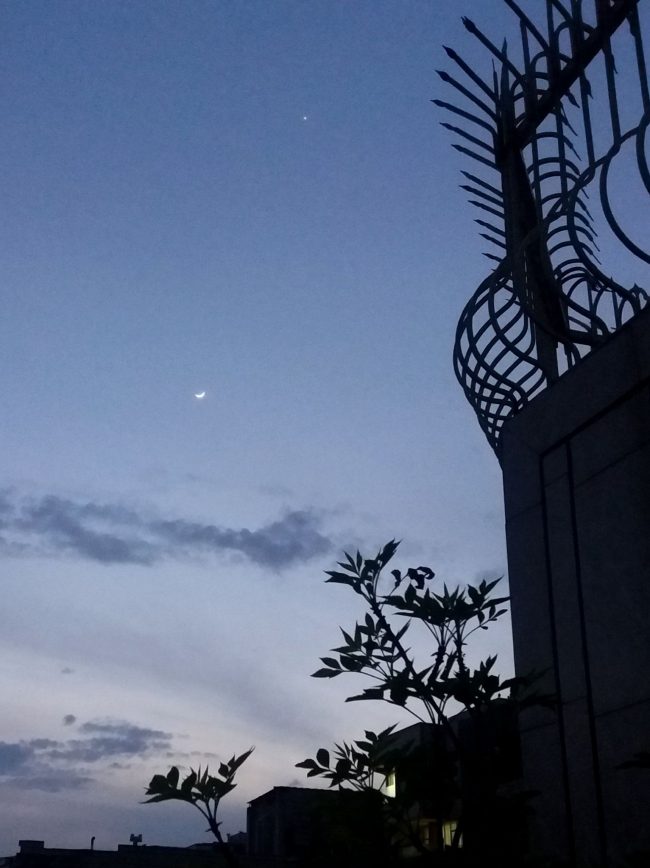
View at EarthSky Community Photos. | Hassan Dadashi.arani in Esfahan, Iran, caught the moon and Venus on March 27, 2020. Thank you, Hassan!
Bottom line: Watch for the brilliant evening couple – the moon and Venus – to adorn the evening sky on March 28 and 29, 2020.
from EarthSky https://ift.tt/2UCSFc4

On March 28 and 29, 2020, the waxing crescent moon and dazzling planet Venus will pop out almost immediately after sunset, lighting up the western evening twilight. Given clear skies, they’ll be hard to miss! You can use the moon and Venus on these evenings to locate the constellation Taurus the Bull, with its brightest star Aldebaran and the famous Pleiades star cluster, also known as the Seven Sisters.
Unlike the stars, which shine by their own light, the moon and Venus shine by reflecting the light of the sun. They are literally heavenly bodies basking in sunshine.

View at EarthSky Community Photos. | Dr Ski in Valencia, Philippines, created this beautiful composite photo of the moon from images captured on March 27, 2020. He wrote: “A wise man once told me that Nature’s beauty, indeed life itself, was made to be embellished. In that light, I decided to capture 2 nice images taken at different focal lengths and present them as one. I’m trying to convey my feeling of wonder and awe as I was enjoying the western view from the Observatory. Being confined in an Observatory is not so bad.” Thank you, Dr Ski!
The Pleiades cluster looks like a tiny dipper. It’s more dipper-like, some think, than the famous Big Dipper asterism, now in the northeast in the evening. Although the Pleiades are also called the Seven Sisters, most people see six stars here. Binoculars show more stars in the Pleiades, and a telescope reveals that this tiny pattern within Taurus is an actual open cluster of several hundred stars.
The star Aldebaran depicts Taurus the Bull’s ruddy eye, and highlights a V-shaped assemblage of stars that outlines the Bull’s face. These stars (with the exception of Aldebaran) make up another open star cluster, called the Hyades. Like the stars in the Pleiades, the Hyades stars are siblings, born from a single cloud of gas and dust. Aldebaran, at a distance of 65 light-years, just happens to be on the same line of sight as this cluster. The Hyades cluster resides well over twice Aldebaran’s distance, at a distance of 150 light-years.

View at EarthSky Community Photos. | Vic Pablo in Luton, Bedfordshire, U.K., caught Venus (brightest object in image, to the right of the pole), and the constellations Orion and Taurus, on March 26, 2020. He wrote: “Facing west an image of Orion constellation on top of the roof. Also visible is Venus and Pleiades on the right side of the wooden post. Aldebaran, Capella and Pollux which is part of Winter Circle is on the background.” Thank you, Vic!

Photo of the planet Jupiter and the constellation Taurus by Stacy Oliver Bryant on April 6, 2013. Note the three stars of Orion’s Belt at upper left. Orion’s Belt always points to the star Aldebaran and the Pleiades star cluster

The 3 stars at the midsection of Orion – called the Belt of Orion – always point to the bright red star Aldebaran, in the V-shaped face of Taurus the Bull. Chart via IAU.
The lit side of the waxing crescent points westward, or in the direction of sunset. Although the moon appears to travel westward (in the sunset direction) every day, this is not the moon’s true motion. The moon, planets and stars appear to travel westward across the sky for the same reason that the sun appears to travel westward during the day. The Earth spins from west-to-east on its rotational axis every day, making it appear as if the sun, moon, planets and stars actually move from east to west daily. But it’s really the rotating Earth that is doing the moving.
However, the dark side of the waxing moon points in the moon’s direction of travel relative to the stars and planets of the zodiac. The moon moves in front of the background stars at the rate of about 1/2 degree per hour or about 13 degrees eastward per day. At the same time for these next several evenings, note the moon’s change of position relative to the “fixed” star, Aldebaran. This is the true measure of the moon’s orbital motion around Earth. Watch for the moon to traverse eastward through the constellation Taurus the Bull these next several days.
By the way, Venus reached its greatest elongation from the setting sun on March 24. Although Venus is now moving westward relative to the sunset, Venus is moving eastward relative to the backdrop stars of the zodiac, but at a slower pace than the moon. Watch the Venus to pass a scant 0.3 degrees south of the Pleiades star cluster on April 3, 2020, and a whopping 10 degrees north of Aldebaran in mid-April 2020. Starting on May 13, 2020, Venus will move in retrograde, or westward in front of the backdrop stars. The retrograde will end on June 25, 2020 (at which juncture, Venus will be in the morning sky).

View at EarthSky Community Photos. | Hassan Dadashi.arani in Esfahan, Iran, caught the moon and Venus on March 27, 2020. Thank you, Hassan!
Bottom line: Watch for the brilliant evening couple – the moon and Venus – to adorn the evening sky on March 28 and 29, 2020.
from EarthSky https://ift.tt/2UCSFc4

Aucun commentaire:
Enregistrer un commentaire